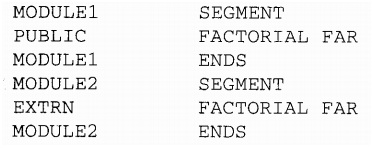END : END of Program:-
The END directive marks the ending of the assembly language program. When the assembler comes across this END directive, it avoided the source lines available later on. Hence, it should be confirm that the END statement should be the final statement in the file and should not seem in between. Also, after the END statement no useful program statement should lie in the file,.
ENDP : END of Procedure:-
In the assembly language programming, the subroutines are called by the name procedures. Thus, procedures may be independent program modules which return specific results or values to the calling programs. The ENDP directive, which is used for denote the end of a procedure. A procedure is generally assigned a name, for instance Label. To mark the end of a program code. The recurring value is assigned having a label, and that label which is used in place of that numerical value, all through the program. at the same time as assembling, whenever the assembler comes across the label, it substitutes the numerical value for that label and finds out the equivalent code. By Using the EQU directive, even an instruction mnemonic may be assigned with a label, and the label may then be used in the program in place of that mnemonic. Assume, a numerical constant appears in a program ten times. If that constant is to be changed in later time, one will have to make all these 10 corrections. This can lead to human errors, because it is a chance that a human programmer can miss one of those corrections. This will result in the generation of wrong codes. If the EQU directive is used to assign the value with a label that may be used in place of each recurrence of that constant, just 1 change in the EQU statement will give the proper and modified code. The examples which are given below show the syntax.
Example :
LABEL EQU 050 0H
ADDITION EQU ADD
The first statement assigns the constant 500H having the label LABEL, whereas the second statement assigns another labelADDITION having mnemonic ADD. EXTRN: External and PUBLIC: Public The directive EXTRN informs the assembler that the names,labels andprocedures declared after this directive already have been defined in some other assembly language modules. In the other module where the names labels and procedures really appear, they ought to be declared public, by using the PUBLIC directive. If anyone wants to call a procedure FACTORIAL that appearing in MODULEI from MODULE 2; in MODULE 1, it ought to be declared PUBLIC by using the statement PUBLIC FACTORIAL and in module 2, it ought to be declared external by using the declaration EXTRN FACTORIAL.The statement ofdeclaration EXTRN oughtto be accompanied by the SEGMENT and ENDS directives of the MODULE 1, before it is called in the MODULE 2. Thus the MODULEI and MODULE 2 must have the following declarations.
